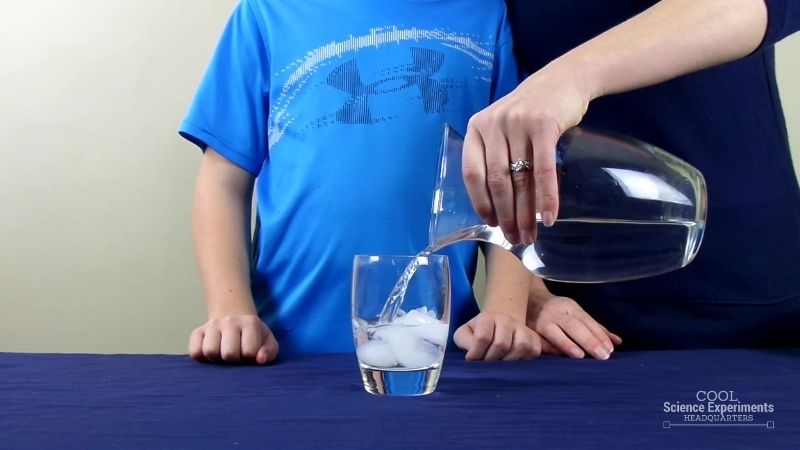Let’s go ice fishing! It doesn’t seem possible to pick up ice with only an untied string, but it is. As long as you have the special ingredient!
This quick 3-minute science experiment uses only a handful of kitchen items and helps kids explore the freezing temperatures of freshwater versus saltwater. A supply list, printable instructions, and a demonstration video are included to make planning easy.

JUMP TO SECTION: Instructions | Video Tutorial | How it Works
Supplies Needed
- Empty Glass or Bowl
- 5-6 Pieces of Ice
- 1/2 Cup Water
- Piece of String
- 1/2 Teaspoon Salt
pick Up Ice with a String Science Lab Kit – Only $5
Use our easy Pick Up Ice with a String Science Lab Kit to grab your students’ attention without the stress of planning!
It’s everything you need to make science easy for teachers and fun for students — using inexpensive materials you probably already have in your storage closet!
Pick Up Ice With String Experiment Instructions
Experiment Setup: Begin by making some observations about the string. Is there anything special about it? Then look at the ice. Is there anything unusual about it? No, it’s a normal piece of string and there isn’t anything unusual about the ice. Do you think that you could use the string to pick up the ice? Write down your hypothesis (prediction) and then follow the steps below.

Step 1 – Put 5-6 pieces of ice into an empty glass or bowl. Then add the water into the glass.

Step 2 – Try to use the string to pick up a piece of ice. You will find that it isn’t possible. Do you think there is anything we can change to make it possible to pick up the ice with the string? Continue with the steps below to find out.

Step 3 – Next, lay the piece of string over the ice. Then sprinkle some salt over the string and wait for a minute. As you are waiting, make some observations. Do you notice anything happening with the ice? What about the string? Write down your observations and then continue to the next step.

Step 4 – After a minute has passed, carefully pick up the string and watch what happens. You were able to pick up the ice. Do you know why?
Find out the answer in the how does this experiment work section below.
Video Tutorial
How to Pick Up Ice with a String Science Experiment Step by Step Instructions
How Does the Science Experiment Work
When salt comes in contact with ice, it causes the ice to melt a little. The small amount of water from the melted ice and the salt combine together, lowering the freezing point of water. Saltwater has a lower freezing point than fresh water by about 4℉. This lowered freezing point makes it harder for water molecules to recrystallize into ice.
In this experiment, once the salt was added to the ice, the ice melted a little and then quickly refroze around the string. This causes the ice to stick to the string when it is pulled out of the glass.
The same concept is used when you add salt to your driveway or sidewalk during the winter. The salt lowers the freezing point of water, causing it to melt so you can more easily remove it.
pick Up Ice with a String Science Lab Kit – Only $5
Use our easy Pick Up Ice with a String Science Lab Kit to grab your students’ attention without the stress of planning!
It’s everything you need to make science easy for teachers and fun for students — using inexpensive materials you probably already have in your storage closet!
I hope you enjoyed the experiment. Here are some printable instructions:

How to Pick Up Ice with a String Experiment
Materials
- Empty Glass or Bowl
- 5-6 Pieces of Ice
- 1/2 Cup Water
- Piece of String
- 1/2 Teaspoon Salt
Instructions
- Put 5-6 pieces of ice into an empty glass or bowl.
- Next, add the water into the glass.
- Try to use the string to pick up a piece of ice. You will find that it isn’t possible.
- Next, lay the piece of string over the ice.
- Sprinkle the salt over the string and wait for a minute.
- After a minute has passed, pick up the string and watch what happens.



Thank you for doing this fun experiment. I think some of my 6 th graders will like to do this. We finished talking about weather and climate last semester and difficult to hands on activities on Zoom.